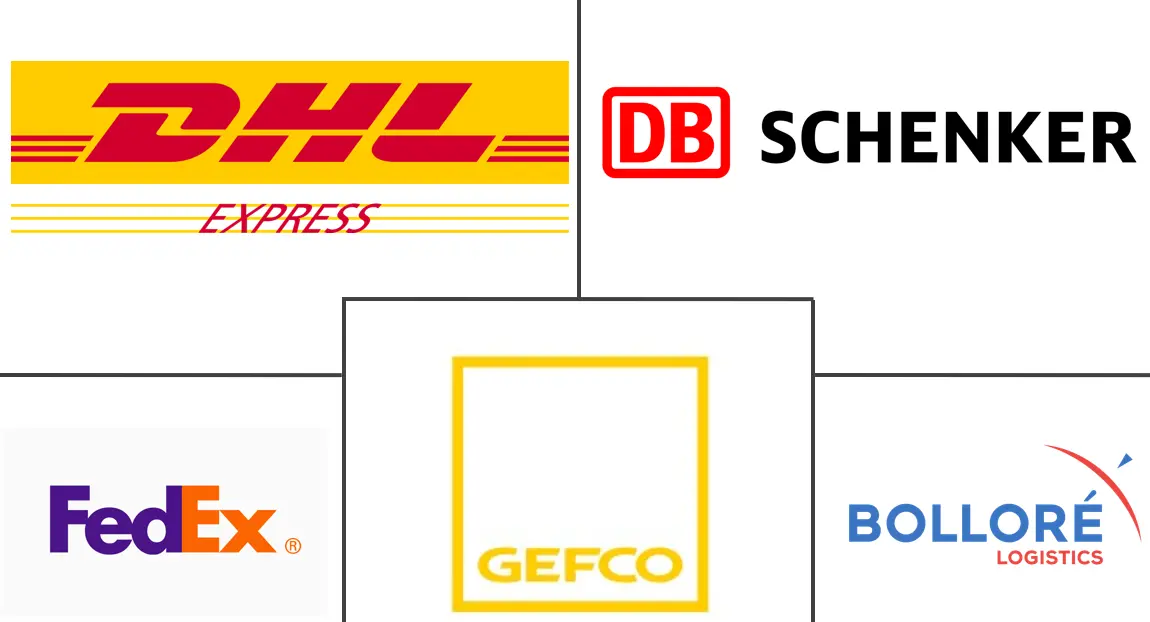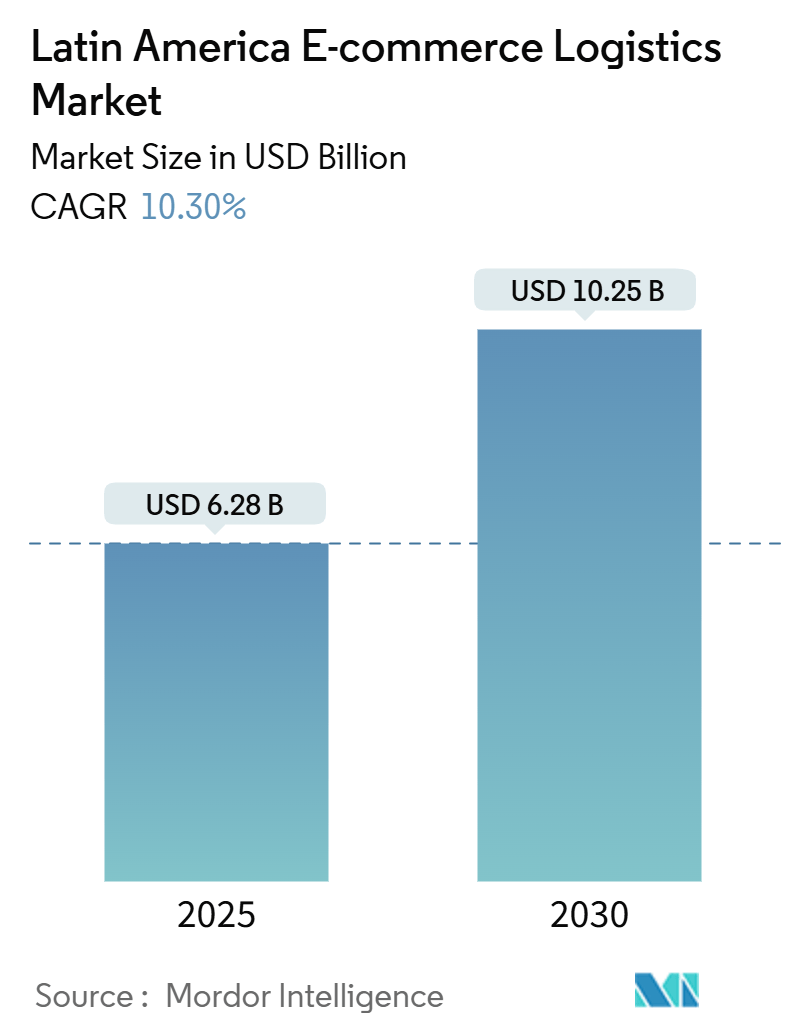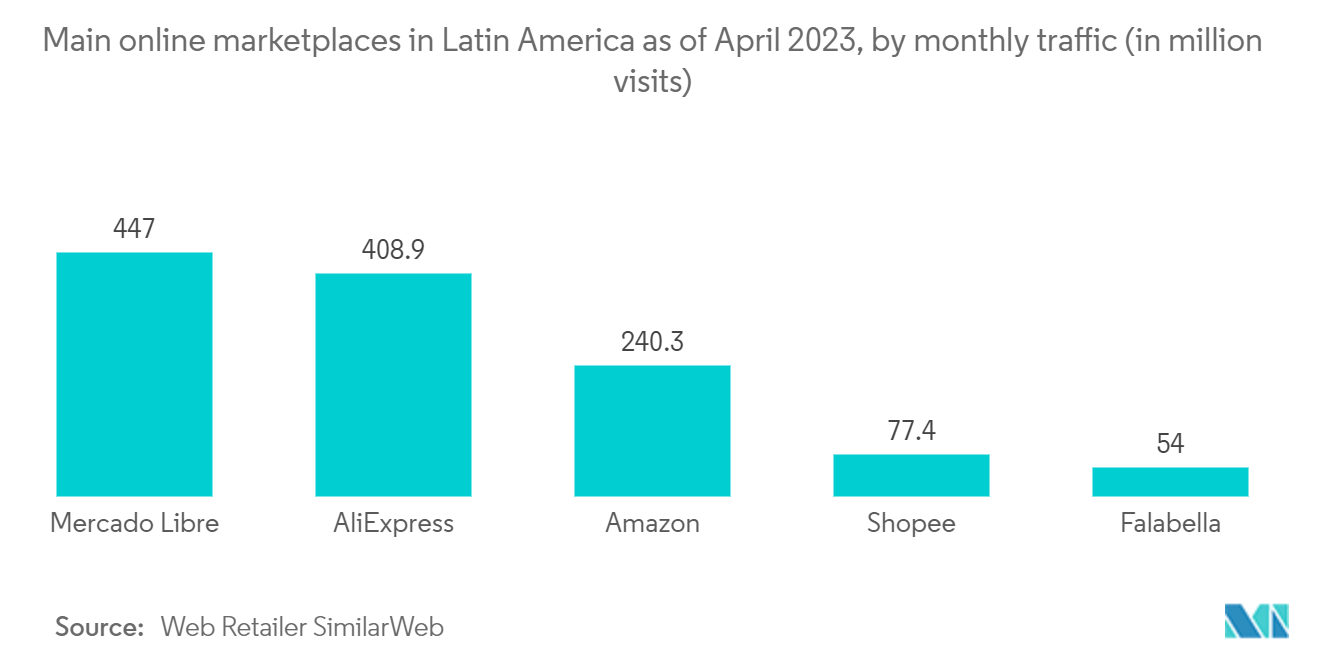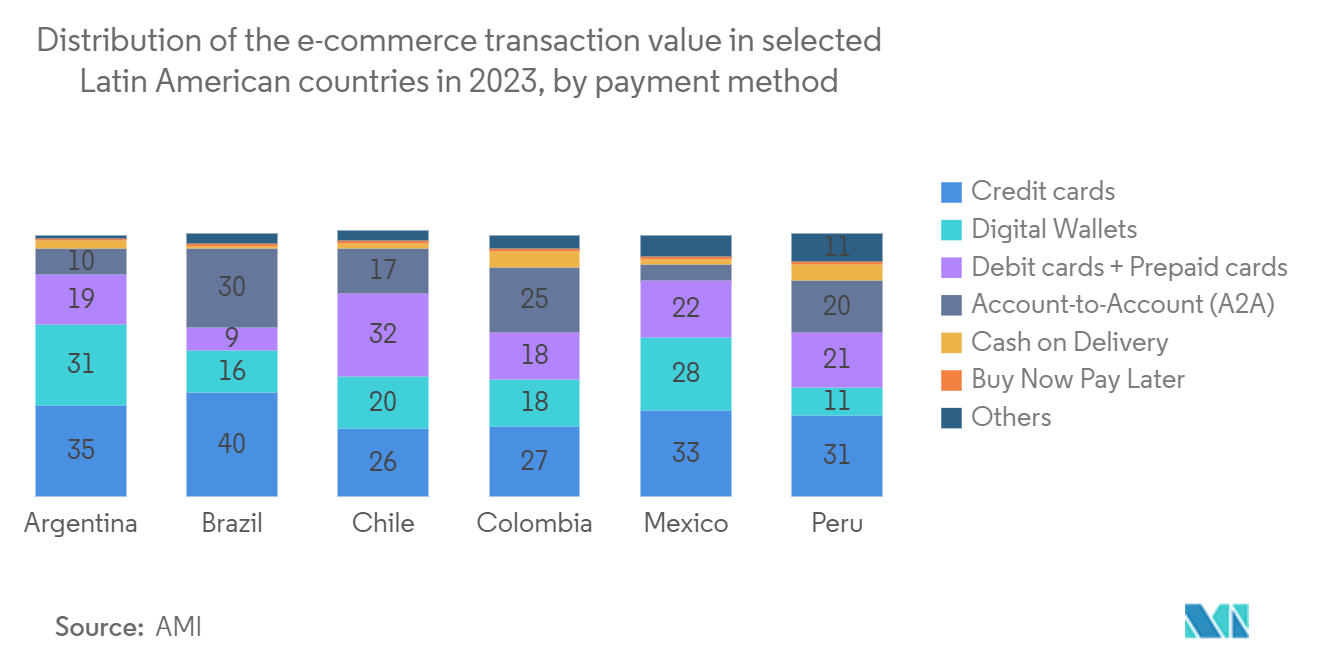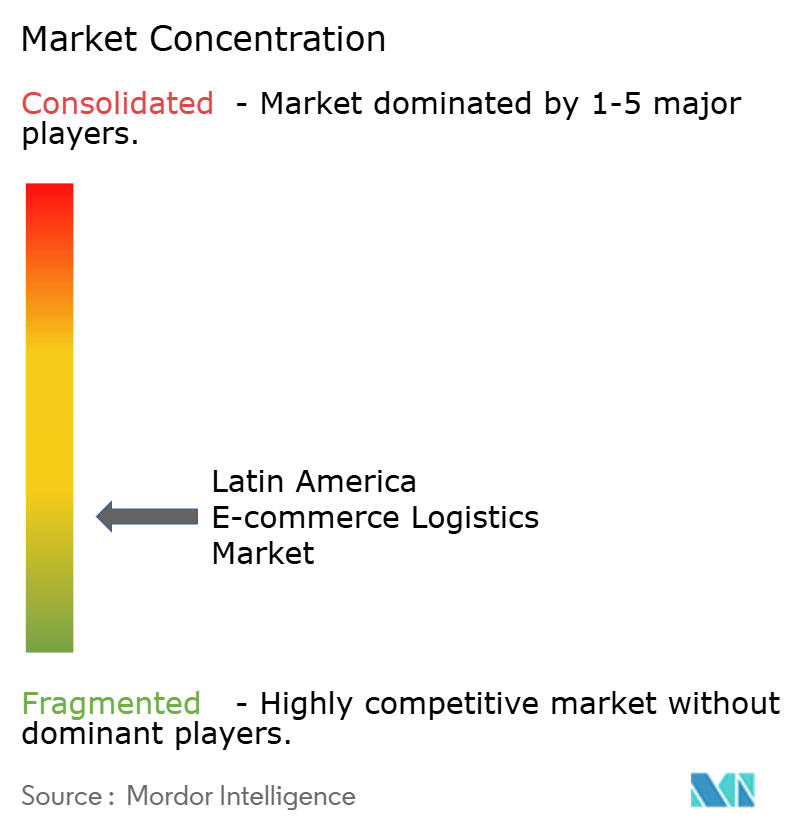Latin America E-commerce Logistics Market Analysis
The Latin America E-commerce Logistics Market size is estimated at USD 6.28 billion in 2025, and is expected to reach USD 10.25 billion by 2030, at a CAGR of 10.30% during the forecast period (2025-2030).
- The COVID-19 pandemic spurred significant growth in the digital realm in 2020, notably benefiting e-commerce. Latin America experienced exponential growth in online shopping, with several countries reporting substantial increases in online purchases, serving as a primary driver for the market.
- The Latin American e-commerce market stands as a global leader in growth, expected to surpass the global average of 14% (as reported in 2021), with an anticipated growth rate of 19% over the forecast period. This robust expansion offers immense opportunities for the e-commerce logistics market.
- The surge in demand for home delivery catalyzed the growth of specific e-commerce segments like food and beverage, which had been gaining popularity in recent years. The digitalization of shopping habits has transcended the initial impact of the coronavirus, becoming an increasingly entrenched aspect of people's daily lives.
- Several significant factors contribute to this market growth, including the rise of e-commerce businesses, the surge in sales, and technological advancements across Latin America. The proliferation of mobile internet usage has also played a pivotal role, enabling people to search for products more conveniently.
- Countries like Brazil, Argentina, and Chile heavily rely on road transportation for moving agricultural products and fertilizers across long distances. Thus, the dependence on efficient logistics and transportation networks ensures competitiveness, indicating a continual growth trajectory for the e-commerce logistics market in Latin America.
Latin America E-commerce Logistics Market Trends
E-commerce Boom Spearheading Last-mile Delivery Demand
- With a population of 386 million, there is an abundance of potential opportunities for e-commerce success in the region. While many would not expect growth in e-commerce during economic unrest, this surge mostly came from the rise in internet and smartphone usage, which provided access to goods from abroad that were previously out of reach.
- E-commerce's rapid growth in Latin America faces a stubborn bottleneck offline with same-day deliveries. Reaching a customer's doorstep faster has drawn investors toward warehouses and fulfillment centers in dense city centers. However, moving goods in and out of mega metropolises like Mexico City or Sao Paulo could be more active at best.
- Van and small truck drivers drive on poor roads amid terrible traffic jams to make deliveries from large warehouses in the sprawling suburbs, often arriving late. While e-commerce companies have shaved delivery times from 7-10 days to 2-3 over the past few years, the target is to reach same-day deliveries.
- Mercado Libre has played a leading role in developing the sector in Latin America. Although the third-party sales giant maintains a growing influence, many competitors are rising to catch up with its e-commerce hegemony.
- The online marketplace created in Argentina remains at the top of the Latin America-born e-commerce companies list. Branching out to digital payments, Mercado Libre's Mercado Pago, its online payments service, processed a staggering USD 50 billion inside and outside the marketplace business model.
Digitization and Inclination Toward Online Transactions
- To circumvent the logistical nightmare of a cash-based society, e-commerce providers targeting the region have found ways to manage this reality. About 40% of online consumers prefer utilizing PayPal, and 38% use cash-on-delivery.
- Moreover, the declining costs of internet services and data and the growing use of credit cards and digital payment systems have reduced the challenges to adopting online shopping. As a result, the sector has captured an 8-10% share of total retail sales in Latin America.
- Brazil and Mexico hold enormous potential for e-commerce in Latin America. There are currently 77.4 million e-commerce users in Brazil, with an additional 38.8 million shopped online in 2023. By comparison, there are 103.31 million internet users in Mexico, accounting for just under half of the population, leaving room for substantial growth.
Latin America E-commerce Logistics Industry Overview
The Latin American e-commerce logistics market is relatively fragmented, with a mixture of domestic and international companies, including DHL, DB Schenker, and Kerry Logistics.
Growing e-commerce activities have led to a high frequency of large-scale deliveries across provinces, giving birth to logistics services specifically for e-commerce activities in the region. Since the e-commerce business environment has become more dynamic and competitive, companies demand better logistics services that are flexible and cost-effective. Value-added services, such as door delivery, real-time tracking, and others, have given a competitive advantage to logistics players who want to build long-lasting customer relationships.
Latin America E-commerce Logistics Market Leaders
-
DHL Express
-
DB Schenker
-
FedEx Corporation
-
Gefco Corporation
-
Bollore Logistics
- *Disclaimer: Major Players sorted in no particular order
Latin America E-commerce Logistics Market News
- June 2024: Yango, a global technology leader, is unveiling Yango Tech in Mexico. The initiative aims to offer patented technologies and expertise to e-commerce businesses and brick-and-mortar retailers in the food sector. With a mission to boost operational efficiency, Yango Tech also seeks to guide traditional retailers in their shift to online platforms. Having established its credentials in over 10 nations across the Middle East, North Africa, and Latin America, Yango Tech is now setting its sights on revolutionizing grocery and convenience stores. The focus is on leveraging cutting-edge technologies to streamline logistical processes, ensuring efficiency from the initial stages right through to final delivery across diverse e-commerce modalities. In Latin America, Yango Tech has forged a partnership with Supermercados Ketal, a trailblazing retail entity in Bolivia. By the close of 2024, the company aspires to expand its clientele, targeting at least 15 new partners across Peru, Mexico, Colombia, and Brazil.
- May 2024: DHL Group's contract logistics division has teamed up with Brazilian startup Levu Air Cargo to introduce a private air transport service. This initiative aims to offer a more dependable alternative to both commercial passenger airlines and trucking, specifically for the domestic distribution of high-value goods in sectors like automotive and healthcare. This collaboration is significant as it involves DHL Supply Chain, diverging from the usual practice of DHL Express. Historically, DHL Express has relied on various companies within the DHL Aviation umbrella for its freighter operations. With an investment of $98.3 million, primarily directed towards upgrading airport facilities and compensating Levu for air services, DHL Supply Chain is making a bold move. However, it's worth noting that DHL isn't taking an equity stake in Levu. The contract is set for an initial duration of seven years.
Latin America E-commerce Logistics Industry Segmentation
E-commerce logistics refers to transportation services provided to the online retail market. For an e-commerce company, logistics in the forward direction involve receiving an online order, arranging for the item, packaging, preparing its invoice, setting the payment, dispatching, and delivering the thing to the customer's doorstep.
The market is segmented by service (transportation, warehousing, inventory management, and value-added services (labeling, packaging, etc.)), business (B2B and B2C), destination (domestic and international/cross-border), product (fashion and apparel, consumer electronics and home appliances, beauty and personal care products, and other products (toys, food products, furniture, etc.)), and country (Brazil, Mexico, Colombia and Rest of Latin America).
The report offers market size and forecasts for the Latin America E-commerce logistics market in value (USD) for all the above segments.
| By Service | Transportation |
| Warehousing and Inventory Management | |
| Value-Added Services (Labeling, Packaging, etc.) | |
| By Business | B2B (Business-to-Business) |
| B2C (Business-to-Customrs) | |
| By Destination | Domestic |
| International/Cross-border | |
| By Product | Fashion and Apparel |
| Consumer Electronics and Home Appliances | |
| Beauty and Personal Care Products | |
| Other Products (Toys, Food Products, Furniture, etc.) | |
| By Country | Brazil |
| Mexico | |
| Colombia | |
| Rest of Latin America |
Latin America E-commerce Logistics Market Research FAQs
How big is the Latin America E-commerce Logistics Market?
The Latin America E-commerce Logistics Market size is expected to reach USD 6.28 billion in 2025 and grow at a CAGR of 10.30% to reach USD 10.25 billion by 2030.
What is the current Latin America E-commerce Logistics Market size?
In 2025, the Latin America E-commerce Logistics Market size is expected to reach USD 6.28 billion.
Who are the key players in Latin America E-commerce Logistics Market?
DHL Express, DB Schenker, FedEx Corporation, Gefco Corporation and Bollore Logistics are the major companies operating in the Latin America E-commerce Logistics Market.
What years does this Latin America E-commerce Logistics Market cover, and what was the market size in 2024?
In 2024, the Latin America E-commerce Logistics Market size was estimated at USD 5.63 billion. The report covers the Latin America E-commerce Logistics Market historical market size for years: 2019, 2020, 2021, 2022, 2023 and 2024. The report also forecasts the Latin America E-commerce Logistics Market size for years: 2025, 2026, 2027, 2028, 2029 and 2030.
Our Best Selling Reports
Latin America E-commerce Logistics Industry Report
The Latin America Cross Border Ecommerce Logistics Market Report provides an in-depth market overview and market analysis of the industry. This comprehensive report is segmented by service, business, destination, product, and country, offering valuable insights into market size and market value. The report includes industry analysis and industry statistics, highlighting the market growth and market trends within the region.
The market forecast and market predictions provided in the report offer a detailed outlook on the industry's future, covering market segmentation and industry outlook. The report also features industry reports and industry research, providing a thorough examination of market leaders and their impact on market growth.
Additionally, the report includes industry information and industry sales data, offering a clear picture of the market dynamics. The market review and market data sections provide a concise summary of the market's performance, while the market outlook section offers insights into future market developments.
For those interested in obtaining a deeper understanding of the Latin America E-commerce Logistics market, the report includes a report example and a report PDF for further reference. Research companies can benefit from the detailed industry trends and market segmentation analysis provided in the report.

